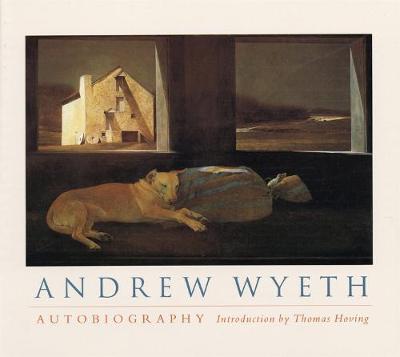Reading this book, that’s really true. He didn’t paint anything he didn’t live with for years. He points out cow tracks, the flight patterns of birds; he knows what changed with the weather that day. On “Weatherside”:
“In the drawing I literally put the building together as if I were the builder, and I actually counted up and studied each one of those clapboards. Up on the right-hand side of the painting, near the top windows, near where the cloth is stuffed into the broken pane, there are a couple of pieces of white wood. They’re from my own house.”
On “Snow Flurries”:
“I spent almost a year on this tempera because I was fascinated by the motion of those cloud shadows on that hill near Kuerner’s farm and by what that hill meant to me. I’ve walked that hill a hundred times, a thousand times, ever since I was a small child, so it was deathless as far as I was concerned. I could probably just paint a hill for the rest of my life.”
On “Road Sign”:
“That harsh shot of yellow in that modern road sign is why I did this picture. Some people said that if I took the sign out, they’d buy the painting. Why would I do that? I love that mesmerizing sign. I’ve almost gone over that corner and crashed, and the thing that made me recall those dangerous moments. Take it out? Hell, no.”
But really, here’s the part I keep mulling over. On “Sailor’s Valentine”:
“Eventually I had to leave that island— it was too good. When I was there, I felt like I was getting out of touch with the earth. The island was too perfect for my personality. You see, I have to go against myself. Many times I find a subject to paint and say, “Marvelous!” Then I think maybe it would be even better for me to walk away from it, and I do. I think it’s interesting to reject things. Keeps me on my toes.”
And on “Wood Stove”:
“I had to overdo it here and reveal all the secrets. Some people say that artists ought to work for utter simplicity. I say to hell with that! Let’s get it all in there! I’m afraid of editing too much; it’s not natural to be simple and pure. It’s not good, either, to show too much artistic ability. You have to fight technique, not let it take over. You can’t be nice around things. Like painting a nude— there’s got to be some ugliness there. I like to paint in places that are not too nice. That’s why I like painting Helga. She’s not in love with the neatless of life or things. My father tried to clean up my paintings. Once he took out the hook that Bill Loper wore for his severed hand. That’s too neat; too nice. Can’t be.”
(My current two favorites of Wyeth’s? “The Swinger” and “The Virgin.” Although that changes often. But here they’re located on two facing pages and that’s a nice touch.)
